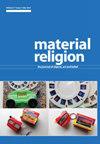The Curious Case of the Condom: How the Secular Matters in the Netherlands
IF 0.4
3区 哲学
0 RELIGION
引用次数: 0
Abstract
Abstract This article argues that the material approach to religion can productively be extended to the domain of the secular, so as to grasp its material dimension. It investigates the Dutch field of sexual health to examine the ways in which the male condom was employed to underscore an image of religion as an obstacle to open conversations about sexual matters. It analyzes how the condom was deployed during sex education classes to evoke discussions about sexuality, but also to demonstrate the organizations’ alleged comfortability with discussing these objects. I argue that, in my fieldwork, the condom materialized secularity because it was key to the introduction of what my interlocutors called “an open attitude” towards sexuality: an open appreciation of sexuality that implicitly references religion as the antithesis of a good sex education class. In doing so, the stereotypical representation of religion as prudish and constrained is reproduced and cultivated through sex education classes.安全套的奇特案例:世俗在荷兰的重要性
本文章由计算机程序翻译,如有差异,请以英文原文为准。
求助全文
约1分钟内获得全文
求助全文

 求助内容:
求助内容: 应助结果提醒方式:
应助结果提醒方式:


